Are the Nobel Prizes Still Relevant?
The Nobel Prizes represent the zenith of scientific achievement. But are they still an accurate reflection of science as it is done today?

THERE ARE SOME MYTHS about the Nobel Prizes: that they recognise the world’s best minds. That every trailblazing discovery of astonishing brilliance is acknowledged and rewarded. That to win a Nobel Prize is to have clambered the pinnacle of human scientific achievement.
Sitting in the magnificent Blue Hall of the Stadshuset, listening to a trio of sopranos in sparkling ball gowns sing Act I of the Swedish opera The Nightingales while holding a flute of Gaston Chiquet Cuvée Tradition in one’s hand, it’s easy to believe that this is, indeed, the apex of science.
Here, on the Riddarfjärden waterfront of central Stockholm, the world’s most exclusive science party takes place on December 10 every year. And only a select few of those attending the celebratory dinner with 1,500-or-so guests get to sit on the long Table of Honour with Sweden’s King Carl Gustaf, from whence he annually rises to offer a toast in memory of Alfred Nobel.
But determining who should be the among the honoured each year, and for what, is subject to often arcane rules drafted more than a century ago — when science was a more genteel endeavour and when discoveries were frequently made by discrete individuals, at times working in isolation. It’s also a process open to human frailty, which can result in those worthy being neglected, those not-so-worthy being lionised, and only the hindsight of history to eventually reveal the gaps.

Which brings me to the Higgs boson, the discovery of which was honoured with the Nobel Prize in Physics at the banquet I attended in 2013. I was shared between Britain’s Peter Higgs and Belgium’s François Englert. In the 1960s, both predicted the existence of what became known as the Higgs boson, a particle believed responsible for giving matter its mass — making it a foundation stone for the entire Standard Model of particle physics. Their discovery proved the power of theoretical physics in a way not seen since the days of Albert Einstein.
And yet, the duo’s win also perfectly exemplifies the mounting doubts about the Nobels, and about how the Royal Swedish Academy of Sciences — which selects the chemistry and physics prizes — determines who wins, and who misses out.
PETER HIGGS is a little like the particle that bears his name. He’s not easy to find, scarcely interacts with others, and yet, when he moves through a crowd, as he did many times during the Nobel festivities in Stockholm, people cluster around him as if some invisible force is drawing them closer.
When we met in Stockholm just before the ceremony, he wore a dark suit and a severe demeanour, but was nevertheless affable when he spoke. His wispy white eyebrows furrowed when he talked about his work, and occasionally a crooked smile broke. The emeritus professor of the University of Edinburgh doesn’t own a television, was only recently convinced to acquire a mobile phone, and the laptop he was given baffles him so much he doesn’t use it. And, at the age of almost 90 now, it’s not surprising he’s a little hard of hearing.
Like the rest of the world, he had a long wait for the discovery of the Higgs boson. He and Englert— along with Englert’s now deceased colleague, Robert Brout — first proposed the theory in 1964, independently of each other, as well as the likely existence of a subatomic particle with zero electric charge that, when it interacts with other particles, imparts them with mass.
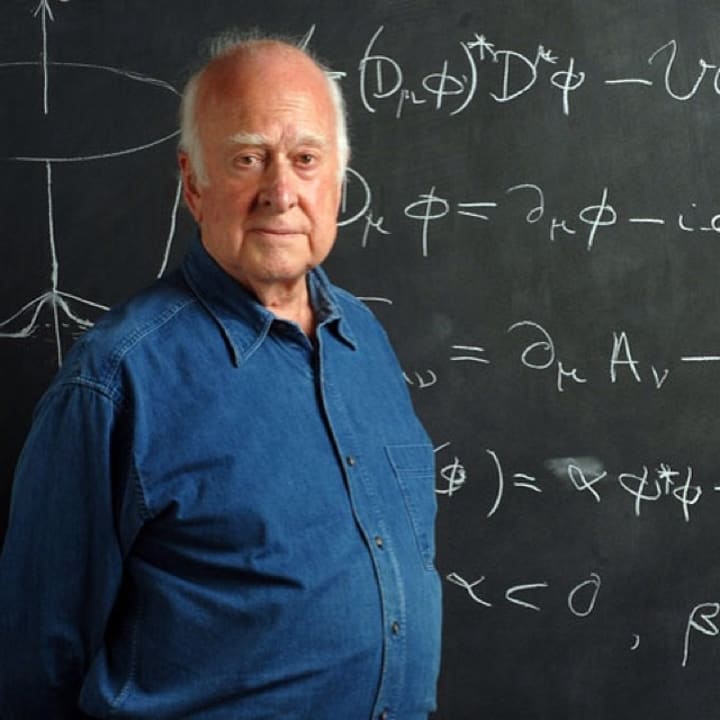
But it took until 2012 — and the largest and most complex machine ever made, the Large Hadron Collider at the CERN laboratory outside Geneva — to eke out enough data from billions of particle collisions to, finally, see the tiny tell-tale spike that heralded the discovery of the first elementary ‘scalar’, or zero-spin, particle ever seen in nature. Now known as the Higgs boson (everywhere, that is, except in Belgium, where it is known as BEH Scalar Boson), the particle they proposed became a reality — and the most famous fundamental particle in the world, even though most people don’t really know what it is.
The theory had, however, an inauspicious beginning: it was met “with a deafening silence”, Higgs told me. Which, he said, was partly justified: “It was a theory in search of the correct application. Those of us who worked in 1964 were trying to apply it to the ‘strong’ interactions in particle physics. Whereas it turned out that it should have been applied to the ‘weak’ interactions … it wasn’t until 1967, when the right home for this theory had been found, that it became a realistic thing to think about whether it was going to be verified or not.”
In atoms, the ‘strong force’ binds atomic nuclei together, while the ‘weak force’ is responsible for some types of radioactive decay. Since 1960s, there have been many alternative proposals to the Higgs model, and most particle physicists remained dismissive of the theory. That was until 1967, when American physicist Steven Weinberg and the late Pakistani physicist Abdus Salam independently formulated a unified theory of weak and electromagnetic forces, known as the ‘electroweak theory’, that placed the Higgs boson at centre stage. The new electroweak theory not only relied on the Higgs boson, but postulated that an obscure particle known as the ‘W boson’ could explain beta decay in radioactive materials, and suggested that a new ‘Z boson’ existed, as well as the likely masses of both.
It was not until 1973 that the neutral current interactions predicted by electroweak theory were detected. In the years that followed, circumstantial evidence for the presence of W and Z bosons began to pile up, mostly in work at the European Organisation for Nuclear Research, better known by its French acronym CERN. The evidence was solid enough to win Weinberg and Salam a Nobel Prize in Physics in 1979, along with U.S. physicist Sheldon Glashow, who extended their work into electroweak unification models. Unambiguous evidence for W bosons finally arrived in 1983, dissolving the last vestiges of resistance among physicists to the Higgs theory.
But there was yet no clear sign of the Higgs boson itself — until 2012. Hence, the 49-year hiatus between the birth of the Higgs theory in 1964 and its recognition with handsome 18-carat gold Nobel medals, a wait that became the longest in scientific history.

AND THAT’S WHERE it gets sticky. By far the most contentious Nobel rule for scientists is that a maximum of three people can share the prize. No exceptions. Hence, three other physicists who also made key contributions to the Higgs field theory in 1964 — Americans Gerald Guralnik and Carl Hagen, and Briton Tom Kibble — could not be considered. Kibble followed up with another paper in 1967 that Higgs called “very influential” and which he believed made Kibble worthy of sharing in the 2013 prize.
Hagen, now a professor of physics at the University of Rochester, believed the Swedish academy should have been less stringent about its rules. “I would have hoped that they would’ve found it in their heart of hearts to include all five of us.” Kibble, an emeritus professor at Imperial College London, agreed. “Our paper was unquestionably the last of the three to be published in Physical Review Letters in 1964 — though we naturally regard our treatment as the most thorough and complete,” he said at the time of the announcement of the 2013 winners.
Is such a restriction still relevant in a world where major advances are often only possible thanks to large teams of researchers? “The rule of three also reinforces the idea that science is carried out by a handful of geniuses, toiling by themselves in ivory towers,” quipped The Economist in an editorial following the announcement of Englert and Higgs’ elevation to the Nobel pantheon in 2013. “If that was ever true, it isn’t now.”
These days, frontier science requires elaborate engineering, often international teams, and scientific papers with five or more authors are common in many disciplines. At CERN, the Higgs particle was finally unmasked by the ATLAS and CMS collaborations, each of which involves over 3,000 people from around the world. They constructed highly complex detectors to study proton collisions from the Large Hadron Collider, itself a mind-bogglingly sophisticated instrument requiring the intellectual toil of thousands of people and scores of institutes to build. The paper in Physics Letters B detailing the discovery of the Higgs boson had 2,936 authors from 178 institutions.
What’s peculiar is that, in principle, more than three people could share one of the Physics or Chemistry Nobels — the original statutes allow “two or more persons together”. But in 1968, this was amended to read that “In no case may a prize be divided between more than three persons.”
What’s more, only individuals are recognised, not institutions. That’s not the case with the Nobel Peace Prize, separately administered by Norway, which has given the medal to organisations like the International Red Cross and, in 2017, to the International Campaign to Abolish Nuclear Weapons. Again, the rules governing the Nobel Prizes explicitly permit the Royal Swedish Academy of Sciences to award organisations: “Each prize-awarding body shall be competent to decide whether the prize it is entitled to award may be conferred upon an institution or association.” But it never has.
Despite Englert and Higgs being the most anticipated winners for the Physics Prize, the award announcement that year by the academy— which is made immediately after a meeting open to all academicians who then ratify the final decision — was uncharacteristically delayed by more than an hour. Rumours circulated in Stockholm that some academicians led a last-minute push to anoint CERN as the third winner, as permitted by the statutes. Another was that arguments were also put for Kibble to be recognised as the third joint winner.
No-one will know the truth for until 2063, when the self-imposed 50-year veil of secrecy that surrounds all Nobel Prize deliberations is lifted. All the academy would say about the delay was that the final decision on winners is made by its members, and that they took their time in “discussing all candidates in order to best honour the will of Alfred Nobel.” Ulf Danielsson, a professor of physics at Sweden’s Uppsala University, and one of the younger members of the academy, noted afterwards that the prize citation also honoured the work done at CERN.
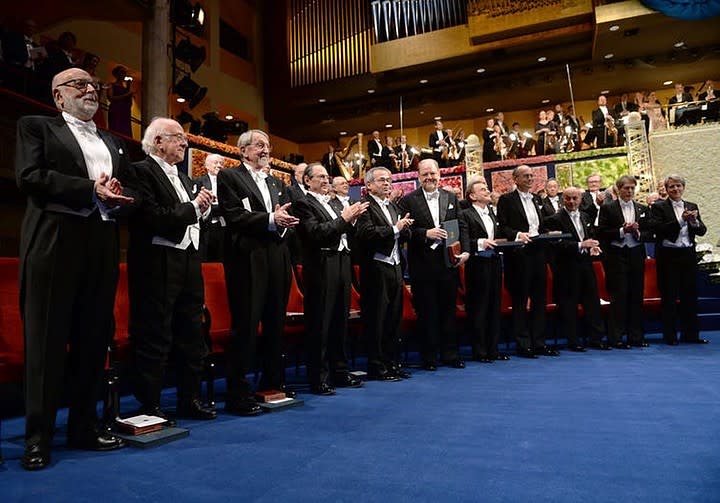
Another contentious rule is that winners must be living at the time of the announcement: “Work produced by a person since deceased shall not be considered for an award.” But this rule is also a recent amendment to the Nobel statutes: before 1974, the Nobel Prize had been awarded posthumously twice — to United Nations Secretary-General Dag Hammarskjöld (1961 Nobel Peace Prize) and Swedish poet Erik Axel Karlfeldt (1931 Nobel Prize for Literature).
Gerald Guralnik, who with Carl Hagen also published key work advancing Higgs field theory, died in 2014; Tom Kibble, whose work Higgs himself through was worthy of recognition, passed away in 2016. And Robert Brout, the American-Belgian theoretical physicist at the Université Libre de Bruxelles, who co-wrote the crucial paper that won Englert his 2013 Nobel, had the misfortune to expire in 2011 — just a year before the discovery of the Higgs boson.
Had Brout been alive, would he have made the lavish party, I ask? Higgs believed so: “I thought that the Nobel committee might stretch the prize to three, and the fact that they just stopped at two, to me, suggests that Robert Brout is being implicitly recognised as one of three who might have got it, had he been alive.”
LARS BERGSTRÖM was secretary of the Nobel Committee for Physics at the Royal Swedish Academy of Sciences when the 2013 award was decided, and had been in the role for a decade. An astrophysicist at Stockholm University working on dark matter, he’s also worked at CERN, is on the editorial board of the Journal of High-Energy Physics, and had recently been elevated to the board of the Nobel Foundation, which administers the six Nobel Prizes given by Sweden. He’s a dapper man in his 60s with pleasant Nordic features, greying hair and an easy smile.
More than anyone, he was responsible for shepherding the selection of candidates for the Physics Prize from nomination to ratification for a decade. And it’s no cakewalk.
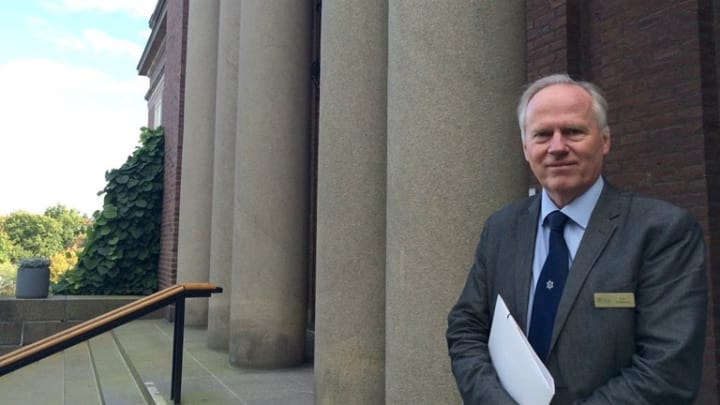
In September, before the winners of each year are even announced, confidential invitations to nominate candidates for the following year are sent out to around 3,000 people: permanent and assistant professors of physics in Sweden, Denmark, Finland, Iceland and Norway; all physics professors in at least six universities outside Scandinavia; and, obliquely “other scientists from whom the Academy may see fit to invite proposals”. The deadline is January 31 the following year, and the reply rate for completed nomination forms averages around 35%.
Each February, the committee — which, like those for all six Swedish prizes, comprise of five members and often two adjunct members, each whom serve three-year terms — screens nominations and selects the preliminary candidates from the 300 or so names received.
This selection is presented to a special meeting of the physics members of the academy — known as the Physics Class — and, based on the ensuing discussions, about 20 potential discoveries are examined in more detail, with reports on each commissioned from experts in the field. By May, the reports come in and, following further discussions with the experts, the committee pares the list down to their preferred candidates, and prepares a detailed proposal over the northern summer. The Physics Class also get these reports and can, if they choose, write competing proposals.
Come September, the seven-person Nobel Committee for Physics submit their recommendations of the final candidates to the academy. Their report is discussed at two meetings of the Physics Class where, according to the rules, at least 18 members must be aged under 65. Based on feedback from these two meetings, the Nobel Committee for Physics selects the winners and writes their citations. In early October — just hours before the announcement is due — the Physics Class meets one last time to review the citations and formally anoint the winners. The decision is made in a majority vote, is final and without appeal.
At this meeting, the Physics Class can, in principle, overrule the committee’s selection, add or subtract winners or alter citations — which is probably why rumours were so rife following the hour’s delay in announcing the 2013 Physics Prize. The delay was unprecedented, Bergström admitted. When asked why, he smiled: “Now we come to things that I’m unfortunately not allowed to tell you.”
As soon as a selection is made, Nobel Foundation staff scramble to contact the winners directly, with just a 30-minute window before the media conference announcing the winners begins. Peter Higgs, who didn’t have a mobile phone with him and was on his way home after a leisurely lunch in Edinburgh, was unaware that he had won until a former neighbour stopped him in the street to offer congratulations.

The process mostly works. Candidates cannot nominate themselves, and would disadvantage their case if they did, or if friends or colleagues tried to intervene in any way. Lobbying on behalf of certain discoveries or candidates is looked down upon, although Swedish journalists who have covered the Nobels for many years say it does occasionally happen behind the scenes.
But the process doesn’t ensure the best minds win, nor that every stupendous contribution to science is rewarded — often because of self-imposed restrictions. Take the 2008 Nobel Prize in Physics, awarded to the Japanese trio of Yoichiro Nambu, Makoto Kobayashi and Toshihide Maskawa for their discovery of the origin of the broken symmetry, which predicts the existence of at least three families of quarks, elementary particles that are a fundamental constituent of matter.
Nambu has long been considered influential, and his early work is what inspired Higgs to develop his own theory in 1964. But many felt that Italian physicist Nicola Cabibbo also deserved the award, as his brilliant work on two quark families laid the foundation for Kobayashi and Maskawa to make their leap forward. Asked for a reaction on the 2008 prize, Cabibbo gave no comment; but he reportedly told friends he was embittered by the decision. It’s worth noting that, to this day, the discovery is officially known as the Cabibbo-Kobayashi-Maskawa matrix — in that order.
Higgs recalled how Cabibbo and Sheldon Glashow (winner of the 1979 Physics Prize) attended the Scottish Universities Summer School in Physics in 1960, of which Higgs was steward — his principal duty being to supply wine at dinner. Higgs recalled the duo “stayed up late into the night in the common room of Newbattle Abbey College discussing theoretical physics, and rarely got up in time for the first lecture the following day. Many years later, Cabibbo told me that their discussions had been lubricated by bottles of wine collected after dinner and hidden inside the grandfather clock.” Cabibbo died in 2010 — so if there was a chance he’d be recognised for his work in future, the rules prevent it.
Another example is the 1965 Physics Prize won by Japan’s Sin-Itiro Tomonaga and Americans Julian Schwinger and Richard Feynman for their fundamental work in quantum electrodynamics. British theoretical physicist and mathematician Freeman Dyson — famed for his work on solid-state physics, astronomy and nuclear engineering — was the one who mathematically proved their three approaches were equivalent, yet he missed out. Weinberg later told The New York Times that the Nobel committee had “fleeced” Dyson by not recognising his work on quantum electrodynamics with the prize.
ONE OF THE OTHER common complaints is the shallow pool of female winners. In physics, of the 210 individuals honoured to date, only three have been women: Marie Curie in 1903 for her work on radiation, Maria Goeppert-Mayer in 1963 for discoveries concerning nuclear shell structure, and Donna Strickland in 2018 for the co-invention of chirped pulse amplification in lasers. That’s 1.4%. The other Nobels fare better: 51 prizes went to women from the 904 given, or just on 6% — an improvement, but hardly laudable, and a repeated source of criticism.
Bergström concedes that, in the past, a tendency to recognise male researchers ahead women may have played a part. An often-cited example is that of Lise Meitner, who first realised how nuclear fission might be triggered, and did a lot of the core mathematics. Meitner, an Austrian Jew, had collaborated with German chemist Otto Hahn for 30 years, and they had worked closely at the Kaiser Wilhelm Institut in Berlin. That was until July 1938, when she had to flee Nazi Germany carrying only hand luggage.

She moved to Sweden to work with her nephew, physicist Otto Frisch, but continued the collaboration with Hahn via correspondence. Letters between the two indicate Meitner gave Hahn valuable insights that helped him tweak the experiments that led him to finally achieve nuclear fission.
Hahn, still in Berlin, published the results in the German journal Naturwissenschaften in 1938 without listing Meitner as a co-author — ostensibly because of the sensitive politics of being seen to collaborate with a Jew. But he also abstained from making the claim that it was fission he’d achieved. Meitner and Frisch later correctly interpreted his results as being nuclear fission, and published a paper in Nature; Frisch confirmed this experimentally the following year, and even coined the term ‘fission’. Nevertheless, Hahn was the solitary recipient of the 1944 Chemistry Prize “for his discovery of the fission of heavy nuclei”.
Meitner never publicly commented on her exclusion, but did object, in a letter to a friend, to how she and Frisch’s role was often dismissed. “I believe that Otto Frisch and I contributed something not insignificant to the clarification of the process of uranium fission — how it originates and that it produces so much energy, and that was something very remote from Hahn.” A 1997 Physics Today study concluded Meitner’s omission was “a rare instance in which personal negative opinions apparently led to the exclusion of a deserving scientist.”
Bergström said he would like to see more women in the Nobel pantheon, especially in physics, but said the Nobel committees are hamstrung by the fact they rely on nominations — and so few women are proposed, especially in physics. The other factor is the long lag times between discovery and experimental confirmation. Take the 2013 prize: it was for work done in the early 1960s, when very few women worked in physics. Nevertheless, he’s a little defensive. “Well, two of the [committee] members are women .. one of them has been for six or seven years. I mean, we shouldn’t blame her that she doesn’t find women either, right?”
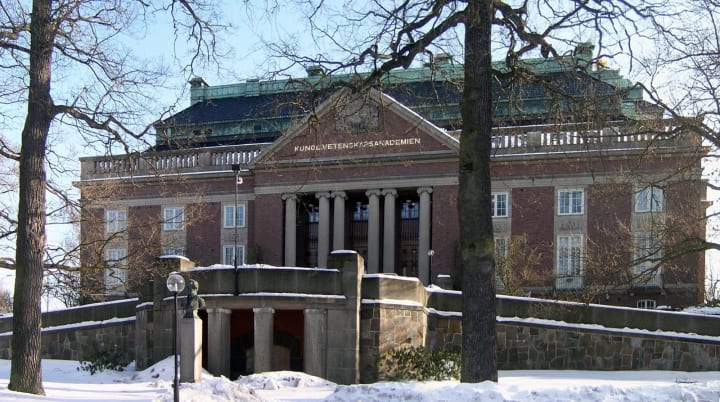
THE ROYAL SWEDISH Academy of Sciences is an imposing neo-classicist building perched on a windy hill overlooking botanical gardens on the northern outskirts of Stockholm. Inside is the room where the Nobel Committee for Physics meets, furnished in dark wood and adorned with a bust of Alfred Nobel by the main window. The snow is heaped outside in the December day I visit, and the interior festooned with portraits of great men of science, many dating back centuries.
The institution may be “rather conservative” Bergström said, as soft winter light streams from the window. But he hints that calls for the Nobel Prizes to adapt to 21st century science are not going unheeded. “There is a possibility that the academy will change its habits of isolating two or three people, because that’s really what Alfred Nobel wanted, that’s written in his will,” he mused.
He also noted that the Peace Prize recognises institutions, which in principle the academy can also do. “Maybe in the future, one would have to do that. If you ask me, I think that maybe in 10 years we might do that, because so much of science these days is done in big collaborations.”
Bergström rises. It’s December 10, and the first nominations for next year’s Physics Prize are already coming in. Before the interview, Bergström had spent a couple of hours going through them.
But this afternoon, he’s looking forward to the awards ceremony in the palatial Stockholm Concert Hall, followed by the opulent evening banquet at the waterfront Stadshuset. There’s a set of white tie and tails waiting for him at home, he said, and he needs to take his leave. “Soon, the hard work starts … But this — this is a great time of the year.”
Like this story? Please click the ♥︎ below, or send me a tip. And thanks 😊
About the Creator
Wilson da Silva
Wilson da Silva is a science journalist in Sydney | www.wilsondasilva.com | https://bit.ly/3kIF1SO

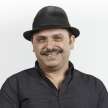




Comments
There are no comments for this story
Be the first to respond and start the conversation.